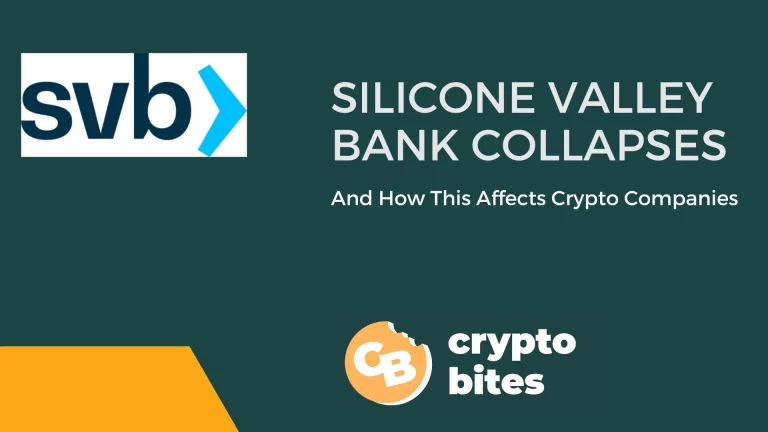
How the Collapse of Silicon Valley Bank Affects Crypto Companies
Before March 10, 2023, the Silicon Valley Bank was the go-to financial institution for tech companies and entrepreneurs. But only two days later, it became the largest bank to fail since the events that folded in the 2008 financial crisis.
Being a bank that provided banking services to most tech companies in Silicon Valley for decades, the failure of such an iconic institution sent shockwaves throughout the industry.
So, what happened that led to the closure of the bank?
In short, the Silicon Valley Bank did not have sufficient cash to pay its depositors. As a result, the regulatory authorities closed the bank.
But if you need the long answer, we have to go back to the pandemic when banks took in more deposits than they could lend out, leading to SVB’s deposits doubling in 2021. The $49 billion SVB in 2018 increased to $102 billion by the end of 2020 and $189.2 billion in 2021.
What Did the SVB Do With This Money?
The SVB had to do something with all this money. They invested the amount they couldn’t lend out into US Treasury securities. While these were super-safe, they were not immune to rising interest rates.
As the interest rates increased in 2022 and 2023, the value of those securities declined significantly, creating losses for the bank and resulting in their ultimate downfall. The bank revealed that it lost $1.8 billion on selling some securities and couldn’t raise capital to offset this hit.
How Did This Affect the Bank?
With the bank announcing that it had sustained losses in the sale of securities, many venture capital firms advised the companies they were investing in to take their business away from the SVB.
The snowball effect led to depositors withdrawing their money from the bank. Coupled with losses from their investments, the withdrawals were so high that the bank could no longer pay its depositors.
But the rising interest rates aren’t the only reason for the bank’s demise. It’s important to remember that the FDIC (Federal Deposit Insurance Corporation) provides insurance for up to $250,000 on consumer bank accounts.
But we’re talking about tech giants and enterprises here with burn rates for millions, if not billions. They did not enjoy the same level of government protection as a regular customer would. Many of them were uninsured, which means they would be quick to withdraw their money in case of turbulence.
In fact, a regulatory filing revealed that nearly 90% of deposits at the SVB were uninsured since 2020. For now, the FDIC has no record of how many deposits were uninsured at the bank’s closing.
How Does SVB Closure Affect Crypto Companies?
The bank run of the SVB has had ripple effects across the cryptocurrency industry. Many crypto companies have had their accounts frozen or closed due to the SVB’s failure. Besides, SVB’s failure has also led to the closure of crypto-friendly banks.
Signature Bank Closed by Regulators
When a large institution like the Silicon Valley Bank fails, there’s an understandable panic. Signature Bank, a bank that was friendly to the cryptocurrency industry and had been providing banking services to many crypto-focused companies, was closed by New York regulators due to ‘systemic risk.’
Superintendent Adrienne A. Harris, a NY official, announced on March 12 that the regulators are taking possession of the Signature Bank per Section 606 of New York Banking Law. The US FDIC will take over the insurance process.
The authorities revealed that this decision came in light of the SVB closure as an attempt by the FDIC and the Federal Reserve to strengthen public confidence in the national banking system and keep the economy from crumbling.
A US Treasury senior official said these actions would limit the spillover effects and consequences of the SVB’s failure. As of December 31, 2022, Signature Bank had deposits amounting to $88.6 billion and was among one of the few crypto-friendly banks in the country.
Walking in Signature Bank’s footsteps, Silvergate Bank, another crypto-friendly institution, announced that it would liquidate voluntarily and shut down in light of recent developments.
The closure of these banks will have a lasting impact on the crypto industry, resulting in lost revenue and increased mistrust in the banking system. Since these banks were providing the backbone of banking services to crypto-focused companies, their closure would lead to a loss of customers and business.
Crypto Amounts Stuck in Limbo
Apart from crypto-friendly bank closures, the crypto industry is also hit by the fact that all of SVB’s customers’ funds, including cryptocurrency deposits and investments, are now stuck in legal limbo.
Ripple Labs is one crypto company going through this, as its CEO tweeted that the company had ‘some exposure’ to the SVB. Although the company has declined to comment on the amount, the CEO has confirmed that the SVB bank run will not affect Ripple Lab’s day-to-day operations.
But here’s the main question: Will Ripple Labs get its money back? That depends on how the FDIC chooses to proceed. For now, the FDIC has announced that the SVB will reopen on Monday, March 13, and be renamed the Deposit Insurance National Bank of Santa Clara.
Depositors who had less than $250,000 in the bank will get their money back as soon as the bank reopens. But depositors with amounts larger than that may or may not get the remaining sum back. The FDIC will give these deposits a ‘Receiver’s Certificate’ for the uninsured amount.
Moreover, the FDIC has announced that it will pay some of this amount to depositors by next week. Additional payments will be made following the liquidation of the SVB’s assets. However, if the bank’s investments are sold at a loss, uninsured depositors may lose their additional amounts.
So, what does this mean for crypto companies with deposits in the SVB? For now, these companies have to wait and see how the FDIC will proceed and whether or not they will get their money back.
Effect on Stablecoins
With the SVB’s decline, the stablecoins are not as stable anymore. After Friday’s events, confidence in the stablecoin sector took a massive hit as the second-most liquid stablecoin pegged against the US dollar – the USDC – lost its peg and dropped to under 87 cents on Saturday.
The drop came after Circle, the stablecoin’s issuer, revealed that it banked a whopping $3.3 billion with the SVB. Another popular stablecoin experiencing the same story is DAI, a dollar-pegged coin that USDC partially backs. DAI traded at 90 cents on Saturday, resulting in Binance and Coinbase pausing USDC to dollar conversions temporarily over the weekend.
Later on Sunday, Circle posted a blog assuring customers that the company would use corporate resources to cover any shortfalls. The news had a positive effect on the market, with USDC and DAI prices rebounding to their dollar peg.
During this time, many traders swapped their DAI and USDC for tether. While previously, the reason for this swap would have been that tether is the biggest stablecoin with a $72 billion market value, this weekend, it was due to the fact that tether does not bank with the SVB.
What Happens Now?
SVB’s closure has raised many questions. Will depositors get their money back? What will replace the SVB? How does this affect other banks?
While the Silicon Valley Bank may seem like a large institution in the tech world, it’s a small bank compared to some larger banks in the US, such as JP Morgan Chase, with over $3 trillion in assets.
But even with that amount, the possibility of a bank run arises because the lack of consumer confidence results in depositors withdrawing their money from banks. A prominent concern with SVB’s failure was that it would scare customers, pushing them to withdraw funds from their respective banks.
Both the Signature Bank and the First Republic Bank saw a 20% decline in share price on Friday. However, the shares of Citigroup, Wells Fargo, JP Morgan, and other large banks did not experience a decrease.
As for what will replace the SVB, the FDIC has taken charge for now. The FDIC will do its best to ensure everyone gets their money back. But if SVB’s assets do not sell for what the bank owes its depositors, there’s a chance some of the money might not be returned.
There’s also a possibility of another bank swooping in and acquiring the SVB. The acquirer will return everyone’s deposits and take on the risk. However, no such news has surfaced yet.
A senior official from the Treasury Department said that the FDIC would use the Deposit Insurance Fund to pay the depositors back, and no public taxpayer-funded bailout would be needed. Since the DIF has over $100 billion in it, it is sufficiently funded to cover the depositors of both Signature and SVB.
For now, it is important to stay vigilant and keep an eye out for any future developments in the SVB’s case. Until then, the effects of the SVB’s failure on the crypto industry remain uncertain and ongoing.




